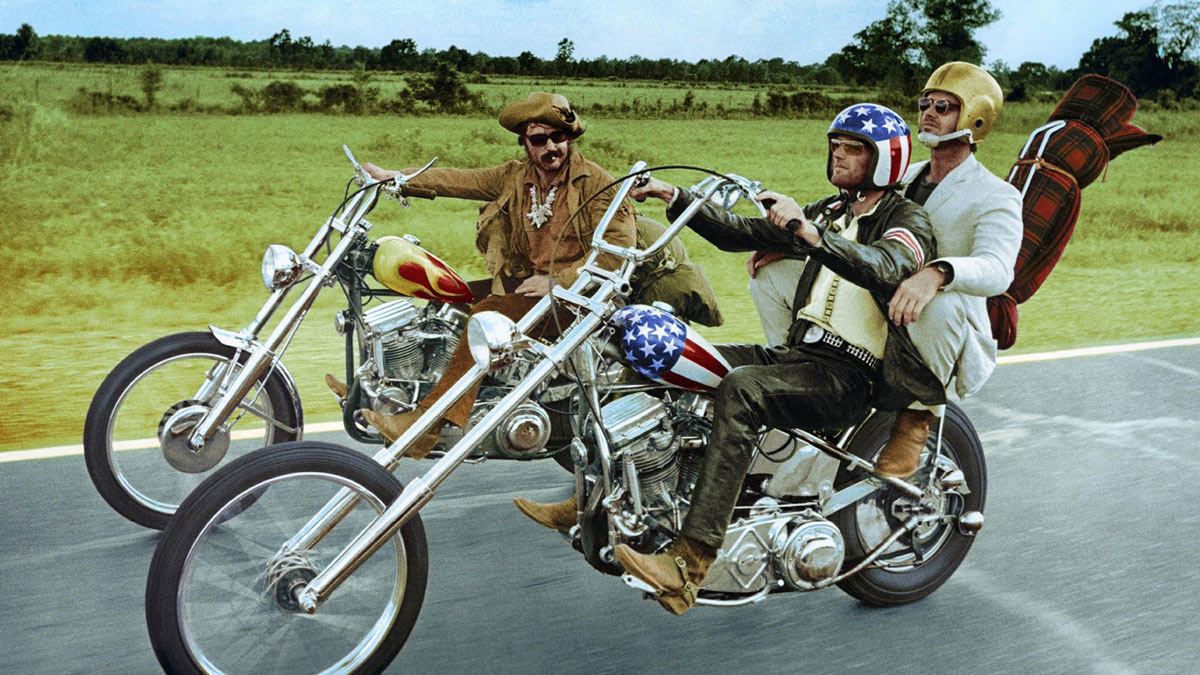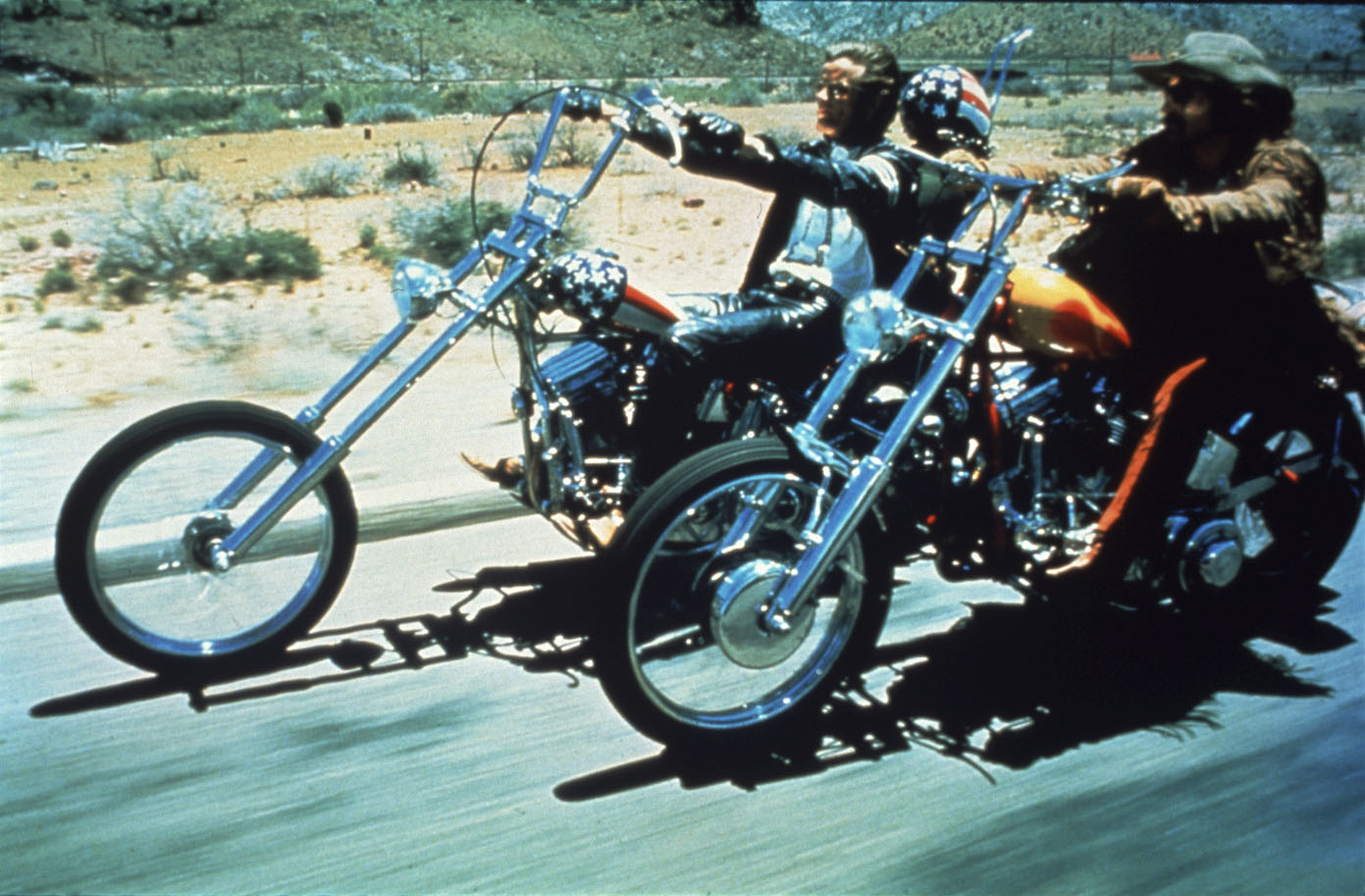
(c) Photofest / Getty Images
Remembering Easy Rider Fonda, Dennis Hopper and Jack Nicholson as they travel freely down the highway in Easy Rider
2019.08.28
Advertising policy in Japan, reaction at Subaruza
The film was released in Japan in January 1970, screening at the Yurakucho Subaruza in Tokyo and enjoying a groundbreaking 23-week run.
"Even today, Subaruza is known as the theater where Easy Rider was screened. It has been shown there many times and has been known as Easy Rider when times are tough," comments Adachi Yoshiyuki (Publicity Department, Subaru Kogyo Co., Ltd.), the current manager of the theater.
Atsuo Omori, a former employee of Columbia Pictures' Publicity Department who was in charge of promoting this film (and is now president and CEO of film publicity company Hidden Figures Arts Inc.), looks back on the film's beginnings as follows:
"I joined Columbia Pictures in October 1969, and my first job in charge of publicity was for Easy Rider, which was scheduled to be released in Japan in January 1970. The subtitles were done by Ota Kunio, but I was called in by the head of the publicity department and told that since this was a film for younger people, I wanted the subtitles to be changed to more modern language," he says. So the newbie, who had just joined the company, worked with a veteran subtitler to create the subtitles. "I was fearless. There were some words that were a bit clichéd, so I told the subtitler to change them to more casual expressions."

"Easy Rider" (c)1969 COLUMBIA PICTURES INDUSTRIES, INC. ALL RIGHTS RESERVED.s
According to Omori, at the time, the media that focused on advertising were radio and newspapers. "Advertising using images, like TV spots, was not yet mainstream. In the case of this film, I thought the music would be a selling point, so I promoted it to radio stations along with the music. Also, print was very powerful in those days, and good film reviews in newspapers could attract audiences, so I tried desperately to get film reviews in major newspapers like Asahi and Yomiuri."
In terms of film genre classification, the framework of "American New Cinema" already existed, so the film was marketed as part of that vein. "Up until then, Hollywood movies had often been overly optimistic, but New Cinema tended to be films that reflected reality. It was a product of the times, which is probably why it seemed fresh at the time. However, no one expected this film to become a big hit in Japan."
However, when he went to the Subaruza on the first day of the film's release, he found a huge queue. The line stretched from the second-floor lobby of the theater, down the stairs on the first floor, into the underground shopping arcade, and then out onto the ground floor, continuing past the Nitto Tea shop, which was there at the time. "At the time, the film industry was said to be in decline, but when I saw the line, I wondered how it was in decline as a newcomer."
The Subaruza has 310 seats, but the first week's audience was about 19,000. At the time, fire laws were not as strict as they are now, so they just packed as many people into the theater as they could. After that, the film ran for 23 weeks, and the theater alone attracted an audience of 178,000.

"Easy Rider" (c)1969 COLUMBIA PICTURES INDUSTRIES, INC. ALL RIGHTS RESERVED.s
"I think one of the reasons it was well received was the fashion. People were paying attention to things like leather jackets and Harleys. The audience was overwhelmingly young," says Omori. Some audience members would come to the theater on modified bikes, and sometimes a row of them would line up in front of the theater.
Meanwhile, according to manager Adachi, audiences came not only from within Tokyo, but also from other areas. "The Subaruza was in an easy-to-find location in front of the Yurakucho station, so customers could be seen from other places. It must have been a time when seeing Easy Rider at a theater in Yurakucho was a status symbol. There was a different manager at the time, but from what I've heard, they also had Harley bikes on display in the lobby."
Later, the theater also showed other masterpieces of American New Cinema, such as " Five Easy Pieces " (1970) and " Vanishing Point " (1971), both starring Jack Nicholson. The former also starred Karen Black, who played the prostitute in "Easy Rider," and was known as her breakthrough film. The film depicts the loneliness of a man who cannot find his place in the world with a dry touch, and director Bob Rafelson's intelligent direction has been well received.
"Five Easy Pieces" Trailer
"Subaruza has also shown many musical films, such as The Beatles' ' Let It Be ' (1970). For Toho, it stands out for its unique works. I think Subaruza was a theater where the manager could do what he liked," says Adachi.
It was this theater that saved the nearly abandoned film " American Graffiti " (1973), and it was also a place to receive films that seemed difficult to sell. Since the 1980s, it has also played the role of an art-house mini-theater, showing New York independent films such as Jim Jarmusch's " Stranger Than Paradise " (1984).
Subaruza will also be closing this autumn. Its predecessor, the Marunouchi Subaruza, opened in 1946. After a fire and other incidents, it reopened as the Yurakucho Subaruza in 1966. This will also be the end of a movie theater that has been with Japan since the postwar period. Before the closure, a memorial screening titled "The Brilliance of Subaruza" is scheduled for October 5th to 20th, and "Easy Rider," the theater's patron film, will be shown for the first time in a long time.
Meanwhile, the work that Omori is currently involved in promoting is Quentin Tarantino's masterpiece " Once Upon a Time in Hollywood " (2019). Coincidentally, the film is set in 1969, the same year that "Easy Rider" was released in the US. The film also features a hippie commune-like setting reminiscent of "Easy Rider," conveying the chaotic atmosphere of the times.
"Once Upon a Time in Hollywood" trailer
"In Japan, it was also the era of the student movement, and the young people who took part in the movement and opposed authority probably believed that they could change the world through their own power. It was an anti-establishment era," says Omori.
"Easy Rider" was a work that conveyed the atmosphere of that era. Incidentally, it was also chosen as the best foreign film of the year by critics in the film magazine Kinema Junpo.
What Fonda said before she died - in lieu of a memorial service

